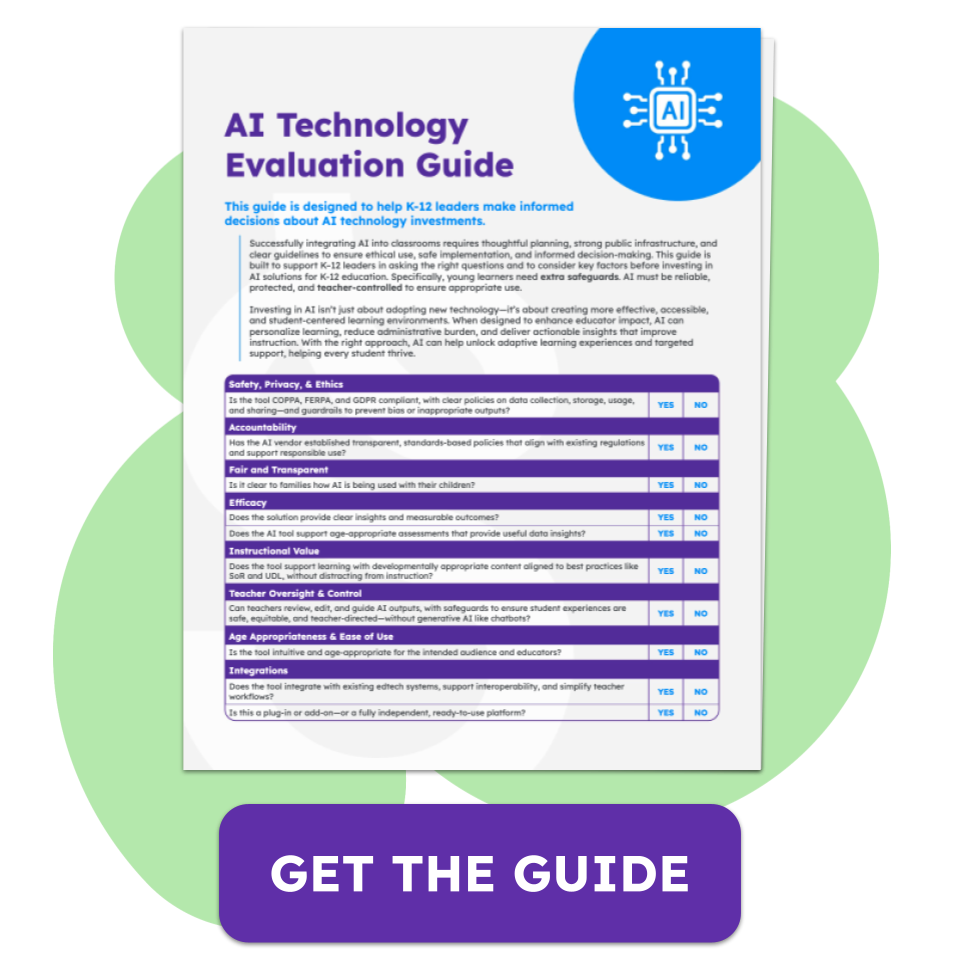AI is transforming education, but that doesn’t mean schools can easily manage the change. As a school leader, you play a critical role in setting the tone for how AI applications for schools enter classrooms. By introducing, supporting, and guiding their use, you create a pathway for success that leads to positive outcomes. In this post, we’ll highlight the “need to know” items that will help you start your AI journey on the right foot. See our AI-enhanced instruction guide for practical steps.
What your teachers are actually worried about
Many teachers aren’t resistant to AI because they refuse to try new things. They worry AI applications “for teachers” will replace them or expose gaps in their teaching. One of the most common fears about AI is that it will replace teachers, but AI classroom tools for teachers are designed to enhance, not replace, their role. The truth is the opposite—AI should support teachers, not replace them. Classrooms are deeply human spaces.
AI should automate tasks that can be automated, giving teachers more time for the human side of education. Your teachers need reassurance that these applications won’t replace them but will enhance instruction and lighten their workload. Give them permission to explore without pressure to be perfect.
What you’ll hear from families
Families will come with questions and concerns, especially if you are being proactively transparent about the use of AI in classrooms – so you should have answers ready. Some will ask how these AI applications are helping their child academically, or how their screen-time will be increased with the use of these applications. Parents may be completely resistant to AI and may ask that their child not use it. Some parents will be advocates, especially if they are familiar with the benefits of these applications in their workplace.
Be ready with clear, simple answers. Creating an FAQ or hosting family education nights are great first steps. Parents want to hear directly from you about how AI in elementary classrooms can improve student outcomes, and they want you to highlight the benefits clearly and positively. Find answers in our AI implementation best practices.
The reality of getting started
Like any new tool or curriculum, AI implementation strategies for school leaders require careful planning and time.. You can’t simply parachute in a new tool and expect it to succeed. Give teachers time to experiment, reflect, and grow their understanding. Even if you’re learning just ahead of them, lead with curiosity and empathy.
Your Teachers Need Encouragement and Guidance
Teachers will look to you and your team for guidance. Even if they don’t say it, they trust that the applications you approve are worth their time. They want to know their effort will pay off in their classrooms.
Lead with confidence and positivity. Create spaces for collaboration and honest feedback so teachers feel supported as they learn.
The Best Approach is an Integrated One
Every new technology takes up instructional minutes, and too much can reduce teaching time. Use those minutes wisely. Start by checking whether the applications you already use offer AI-powered learning features for K-5. Partnering with familiar vendors can create a win-win: teachers keep the applications they know while gaining more value to instruction from AI enhancements.
Common Pitfalls of AI
To avoid any missteps, keep an eye out for some of the most common pitfalls:
- Over-relying on AI and removing human intervention from the classroom
- Implementing too many applications, too quickly, or allowing full freedom for teachers to access the applications they think they need
- “I feel like it’s happy hour all over again with all of the AI tools, but for K5 we are using Seesaw and that’s our official LMS.” – Joshua Ehret, Instructional Technology Specialist, Wichita Public Schools, KS
- Focusing on just technical training of how to use tech and not embedding t pedagogy, instructional design, or practical classroom applications
- Making the assumption that all AI applications are safe, equitable, and unbiased
When done right, AI can help
AI in classrooms can improve student outcomes. These applications can give teachers time back, streamline decision-making, and eliminate monotonous admin tasks. But the success of this technology depends on your leadership.
Prioritize support and sustainability over speed and novelty. When you champion the right AI applications, you’re not just adopting technology, you’re leading the way in AI strategies for elementary schools that build better learning environments. Learn more about AI-enhanced instruction for schools to lead with confidence.




